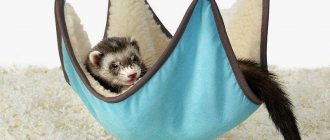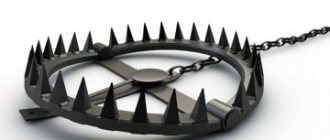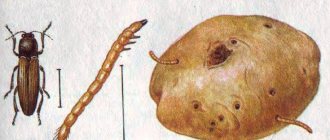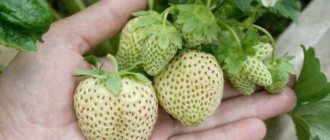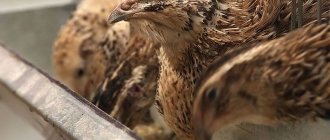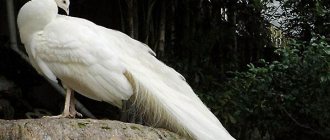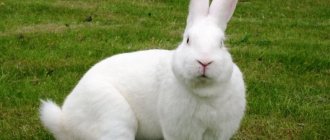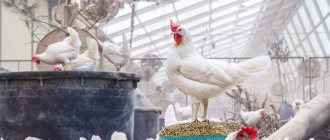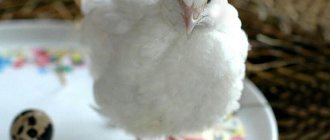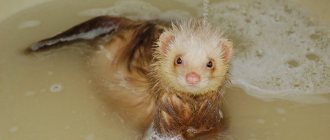A representative of the order of predators is the white ferret, which lives in flat areas. As a cute pet, he has proven himself to be a playful and very active creature that quickly gets used to people. However, we must not forget that the animal has the habits of a predator. If an animal senses a threat looming over its life, it immediately uses its fangs and a liquid with an incredibly foul odor, which is produced by special glands, to defend itself.
Representative of the order of predators - white ferret
Ferret at home: pros and cons
Ferrets, like any other pet, make great friends and are soon treated as part of the family by their owners, but there are still pros and cons to keeping a pet at home that you should be aware of before making a new friend. .
Capybaras, weasels, hamsters, caracals, mongooses, lemurs, newts, Tasmanian devils, snails, crocodiles, leopard geckos, snakes, rats, mini pigs, and rabbits can act as pets.
Everyone is in favor
As for the undoubted advantages of this animal, among them are:
- Easy to care for. Although ferrets are considered quite active animals, caring for them is quite simple.
- Love for games. The animals are happy to make contact, play with their owners, can bounce merrily and make interesting sounds.
- Friendliness. Ferrets are quite kind by nature and get along well with other pets; they can play and have fun with them.
- Curiosity. Although sometimes this curiosity becomes the cause of chaos in the house, it is still so interesting to watch the animal during its activity period.
Everyone is against
Despite the fact that the ferret has many advantages, you should also be aware of some disadvantages so as not to be disappointed in the animal after the purchase:
- As stated above, ferrets have specific glands that can release odors in the most unexpected situations. Therefore, if you have purchased an animal, try to protect it as much as possible from stressful situations.
- A lot of money is spent on frets, despite the ease of care. In order for the animal to feel comfortable, it needs to buy expensive, high-quality food, get regular vaccinations, arrange a good home, not to mention numerous toys and accessories so that it does not get bored. /li]
- Be prepared for the fact that the most important and necessary things may disappear in your house, which you may find a week, month or year later in the most unexpected place where a prankster will make a hiding place. The ferret will undoubtedly find the most secluded place and will sneak everything he likes there.
- These animals cannot give up their love for holes, so they can gnaw holes in furniture, trying to dig a tunnel in them.
Did you know? Ferrets are born blind and deaf; they remain in this state for another month, while they practically do not make any sounds. A newborn ferret is so small that it can fit in the palm of a two-year-old child.
Plant food
The ferret is a carnivorous animal, therefore the predominance of plant components in food leads to negative consequences for the health of the animal:
- There is no amylase enzyme in the saliva of predators, so starch is not broken down during eating and is not converted into oligosaccharides. As a result, a fermentation process begins in the intestines, which ends in disorder.
- The ferret's body is not equipped to process glucose; for the animal's pancreas, it carries the risk of forming malignant tumors.
- The short intestine of a predator does not allow carbohydrates to be absorbed.
- For the normal functioning of the body, a ferret needs to receive a sufficient amount of animal fat; organic matter is responsible for the functioning of the sebaceous glands, so the lack of a component in the diet causes dry skin and hair loss (alopecia).
Plant proteins are poor in composition, they do not contain the necessary amino acids, such food is not able to provide them to the animal’s body.
At a fur farm for breeding polecats, to increase the profitability of production and reduce the cost of products, an experiment was carried out, and part of the protein food for the animals was exchanged for a plant component. Its composition was increased to 60% of the total daily diet. As a result, the experiment failed, the consequences were depressing:
- the animals grew poorly and gained weight;
- Gastrointestinal pathologies have developed;
- fur has lost its original quality;
- sexual hunting has decreased;
- the number of offspring decreased.
Currently, the composition of plant foods ranges from 15 to 20%.
Farshekasha is a good food option, but it is important to give it in portions
Who is a ferret and how long does it live?
Domestic ferrets are called differently: fretka, furo, honorik, thorzofretka. All of these terms apply to the domestic ferret. The word "fretka"
came to us from Poland along with domestic ferrets brought from there.
The Thorzofret
is a cross between a domestic ferret and a wild one.
Furo
is an albino ferret.
Honorik
is a hybrid of a ferret and a mink, but now there are almost no of them left, and this name is mistakenly used for the same ferrets.
Ornamental ferrets, which are now gaining popularity around the world, are actually a domesticated form of the wild ferret. These are predators from the mustelid family, which also includes badgers, martens, weasels, skunks, etc. They were domesticated about 800 years ago and were widely used for catching rodents. Recently they have attracted great interest as decorative pets for city apartments.
Domestic or ornamental ferret
- a small animal with an elongated body and dense fur. The body weight of especially large males can reach 3 kg, females are noticeably smaller. The animals are nocturnal, and spend most of the day sleeping in their shelters. Ferrets live quite a long time, under good housing conditions - up to 12-13 years. Females and males differ from each other both in appearance and in character.
Numerous family of mustelids
In the scientific classification, the steppe ferret is called Mustela eversmanni. It belongs to the weasel family. That is, distant relatives of the animal are stoats, minks, solongoi, weasels and, in fact, martens. This small carnivorous mammal belongs to the genus of weasels and polecats. The second word of the scientific name of the animal - eversmanni - pays tribute to the Russian zoologist E. A. Eversman (1794-1860), who described this species. The closest relatives of the steppe inhabitant are the forest (Mustela putorius) and black-footed (Mustela nigripes) chori, as well as the ferret (Mustela putorius furo). They can mate with each other and produce viable offspring. Many hybrids have been bred by humans: for example, Honorik, obtained from a union with a mink. Although all species of ferrets have different habitats, they quickly adapt to new conditions. Thus, forest ferrets were brought to New Zealand to combat the growing rat population. As a result, adapted small predators now threaten the island's native fauna.
How to stop a ferret from biting?
The ferret is a small, nimble predator that is given teeth to hunt and defend itself. Therefore, biting and biting is the norm for him, an unconditioned reflex.
Having the basics of the art of raising a pet, you can achieve good results. Unintentional aggression in ferrets occurs very often during play.
If the animal bites, you need to strictly and loudly say “No!” or “You can’t!” and push him away, making it clear that his actions are unpleasant to you.
If the bites recur, it is better to stop playing and put him in temporary isolation in a cage. For many, this approach is understandable and the result is not long in coming.
Domestic ferrets need to be taught not to bite from childhood
But there are animals from the “tear it off and throw it away” category, with which you need to be more harsh: during an attack, press the ferret to the floor and hiss at it or shake it, grabbing it by the withers.
You need to release only after the animal has completely calmed down in order to get the correct reaction. After a series of such procedures, the pet begins to understand that biting does not entertain the owner and moves on to other options for mischief.
Coat types
The color of the coat, nose and eyes is not the only difference between domestic ferrets. These animals can have different types of fur. Working to produce different colors and patterns, breeders developed ferrets with long hair—it stays fluffy without much maintenance.
Wool options:
Angora. The guard hairs reach a length of 7-12 cm. Males have longer hair than females, so they look fluffier. Ferrets with Angora hair have a distinctive feature - their nostrils have an unusual twisted shape.
Half Angora. In semi-angora ferrets, the hair reaches a length of 5 cm, on the belly - 3.5 cm. The phenotype of semi-angora ferrets is assessed based on the results of spring molting, since 3.5 cm corresponds to the length of the coat of normal-coated ferrets in winter.
Normal coat. Hair length in winter is 3.5 cm, in other times – 3 cm. Normal-haired animals have a dense and dense underfur.
Angora ferret
Half Angora
Normal coated ferret
Caring for a ferret at home
To prevent feces from being scattered in the corners, the tray is securely fixed. If the ferret has not learned the skill of emptying into a tray from its mother, it will have to be taught something like this:
- Take the animal in your arms immediately after it wakes up for about five minutes.
- If you notice signs of anxiety (the animal backs away and raises its tail), place it in the tray.
- After successfully completing the act, reward your pet with praise and treats.
If excrement appeared on the floor while the ferret was walking around the apartment, scold it and place it in the enclosure. Place him there about once every half hour until the urine/feces remain in the tray.
If you want to wash your pet, use shampoos for ferrets, cats or children. The ferret is washed in a bath with warm water no higher than +40°C, rinsing off the foam in the shower. After the bath, dry him with a soft towel and take him to a box with clean rags, where he will complete the drying process.
Domestic ferrets require care because they are deprived of the ability to dig frequently, which is why their claws grow. They are trimmed once a month with a cat's nail clipper or ordinary scissors, trying to bypass the blood vessel. If you get it, lubricate it with iodine. Enzyme-based preparations that not only mask but neutralize odors will help get rid of the specific aroma of a ferret. The most popular means:
- Zoosan (Russia);
- Miracle (USA);
- Dezosan (Russia).
They are also used to process the tray and remove marks.
Hygiene procedures
In order for the fret to look neat, it should be carefully looked after.
Trim your animal's nails every three weeks. Otherwise, they will grow too long, and it will be difficult for the animal to move.
The ferret needs to be bathed. Not all animals love water treatments. You cannot wash the animal by force, otherwise it may bite the owner and scratch his face and hands.
How to bathe a ferret:
- you cannot turn on the tap while bathing the animal, as the noise of the water will frighten it;
- you need to make sure that water does not get into your ears or eyes; to do this, lubricate the skin around them with Vaseline or a greasy cream;
- washing the face is allowed only with water without hygiene products;
- It is forbidden to turn the animal on its back;
- when there is no special washing shampoo, you can use baby shampoo; you should not use soap or products for other pets, since they have an unsuitable pH, which can cause dysfunction of the sebaceous glands;
- After the bath, the animal should be dried with a dry towel and the fur should be combed with a massage brush.
It is better to watch the video on how to wash a ferret for the first time, otherwise, if you do it incorrectly the first time, the ferret may get scared and it will be problematic to bathe him in the future.
Natural enemies
Many of their natural enemies live in the same territory as ferrets, such as:
- Foxes and wolves that are capable of hunting ferrets, especially in winter, when they do not particularly have to choose victims for food.
- Birds of prey, in the form of night owls and golden eagles.
- Wild cats, for whom catching a ferret is not a problem at all.
- Large snakes, although they are not always able to cope with such a mobile animal.
An equally dangerous enemy of the ferret is humans, who cause serious harm to the population of these useful animals, not only exterminating them, but also surviving from their natural habitats.
As a result of human economic activity, populations of small animals that are part of the diet of these predators are declining, which threatens the existence of ferrets no less than other problems.
Habitat
Habitat of the steppe ferret
The distribution area of the steppe polecat is extremely wide: this animal and its subspecies are found throughout temperate Europe and Asia, right up to the Far East. Can live at altitudes up to 2500 m.
In the European part of the continent, the mammal is conventionally divided into two main populations. To the west of the Carpathian Mountains, the subspecies Mustela eversmanni hungarica predominates. The animal can be found in the following countries and areas:
- Czech Republic;
- eastern part of Austria;
- south of Slovakia;
- south of Ukraine;
- Hungary;
- Yugoslavia;
- north and west of Romania.
The eastern subspecies have spread to the following territories:
- northern Bulgaria;
- southern Romania;
- Moldova;
- east and north of Ukraine;
- southeast Poland;
- southern European Russia;
- Kazakhstan.
The favorite habitats of the steppe polecat are plains, mountain steppes, gentle slopes of ravines, and livestock grazing.
What does a ferret eat?
The European forest ferret feeds primarily on mouse-like rodents, amphibians and birds. A typical diet includes:
- gray rat, common vole and forest vole;
- European water rat;
- brown frog and green toad, lizards, insects;
- birds - gray partridge, pigeons, passerines, chickens, grouse, geese;
- European rabbits, hares;
- snakes - common snakes, aspis viper;
- common hedgehog;
- honey;
- carrion.
Unlike weasels and stoats, ferrets willingly eat carrion, especially large animals left behind by large predators. In coastal areas, animals often feed on water rats and frogs. In Russia, the main food of the predator is voles; in Europe, the animals more often hunt birds. In Britain, the animal feeds mainly on rats and rabbits.
In winter and spring, in times of famine, the animals plunder the hives in search of honey and switch to amphibians, mainly frogs. Snakes, hedgehogs and insects are occasionally included as additions to the main diet. The predator usually kills the prey with a single bite on the neck.
Unlike their forest relatives, steppe ferrets feed on larger steppe mammals. The basis of the diet is:
- ground squirrels;
- young or weakened marmots;
- hamsters;
- pikas;
- water rats;
- chickens, gray and white partridge.
The animals hunt ground squirrels throughout the year. In the summer, predators track prey on the surface, and in the cold season they climb right into their burrows after it. Males have to expand the hole to get to the victim, while females freely fit into the den due to their smaller size.
In places where there are no ground squirrels, steppe ferrets feed mainly on pikas, hamsters, ground squirrels and water rats. On occasion, a predator can catch a partridge or chicken; in coastal areas it feeds on fish and does not disdain carrion. Rarely eats amphibians and reptiles.
The black-footed ferret's diet consists of 90% prairie dogs. The remaining 10% varies depending on the habitat, and usually consists of mice, voles, white-tailed hares, and rabbits.
Appearance
The color of ferrets is very diverse, and depends both on the habitat and on the species
The wild ferret is a very cute animal, having a light or black color, and also, regardless of the subspecies, a peculiar dark mask in the shape of glasses on its muzzle.
What an animal looks like depends on its species, habitat, and domestication, for example:
- The steppe, that is, white ferret, has light, beige fur, which is visually divided into tall hair and soft and dense down. The animal's paws, as well as its muzzle, have darker shades.
- Blackfoot. The ferret (photo below), classified as this species, is now almost extinct, despite attempts to artificially increase the population of these small predators. The fur has a rather interesting, heterogeneous color. In general, upon visual examination, the animal has an uneven, yellowish-brown color.
- Black or forest. Representatives of this species can have a variety of colors, up to red and brown shades. However, as justifies the name of the species, the fur of most predators is black, with a slightly decreasing depth of color on the back.
- Home or decorative. There are many variations in the color shades of a domesticated animal; it can be brown, silver, beige, or white ferret. However, regardless of color, almost all animals have a dark mask on the face, which is a kind of calling card of the species. It should be noted that the term “white ferret” often implies albinos, which is not uncommon for this species.
Despite some differences in color shades, almost all animals have approximately the same parameters of body length and weight.
Thus, the animal has an elongated body, a narrow muzzle, a wide mouth, and dark eyes.
The weight of average representatives usually does not exceed 1.5 kg, body length is about 40 cm.
Ferret fur is valued by fur coat manufacturers, along with arctic fox and otter.
Caring for a Ferret: Difficulties
Caring for a pet is not difficult, but it does take time. Ferrets are quite clean animals; if their litter box is not cleaned in time, they will leave traces in another cleaner place. Thus, if you were a little lazy and didn’t clean your ferret’s tray in time, be prepared to clean it elsewhere in the apartment.
In general, even a litter-trained ferret from time to time does his business in another place, simply not having time to reach his toilet. This means that the issue of cleaning will always be acute. Stock up on plenty of disinfectants and patience.
Mischievous ferrets love to spoil and hide things. You will have to monitor your wardrobe very carefully and be aware that an item left unattended will most likely never return to you. At least intact. So, if accuracy is not your thing, then you will have a very difficult time with a ferret.
If you have a greenhouse of domestic flowers in your apartment, alas, you will also have to say goodbye to them. As soon as the pet gains access to the flowerpot, the flowers will end. What to do, this is an instinct inherent in nature. The ferret digs holes in its natural habitat and this cannot be changed in any way.
Other small pets in the house, such as hamsters, birds, rabbits, guinea pigs, will become objects of hunting for the ferret. It is simply impossible to keep small animals and ferrets in the same area.
All this is the other side of the coin. There are quite a few downsides, so weigh your options before making a decision. If you feel unsure about at least one issue, postpone the purchase. After all, a ferret is not a living toy. Returning it to the store or looking for another owner will be a problem not only for you, but also serious stress for the animal.
Tama the Cat: Train Station Master
This happened in the early 2000s, when the unprofitable Kishi station in the Japanese city of Kinokawa was almost closed due to unprofitability. Residents, of course, protested, but it is unlikely that their efforts would ultimately be crowned with success. The situation was saved by a local cat named Tama, who loved to bask in the sun near the train station. The station manager noticed how enthusiastically passengers reacted to this couch potato and gave him the official position of caretaker. The cat was given a uniform cap, a badge and a monthly salary in the form of free food.
The duties of the newly minted minister included advertising functions. He greeted passengers, allowed himself to be petted, and was always somewhere on the platform. It must be said that this policy very quickly led to commercial success. Tourists began to come to Kishi station just to look at the railway cat and take pictures with him. From that moment on, there was no further talk about closing the station.
But the unusual cat's career did not end there. In 2008, Tama became a supervisor and was charged with monitoring the performance of professional duties by staff. That same year, the cat was knighted. Another year later, according to the project of the famous designer Eiji Mituku, the railway included in the schedule a train dedicated to the legendary animal. The carriages were painted with views of Tama, the locomotive was decorated with his muzzle, and meowing signaled the opening (closing) of the doors. But this did not become the crown of the cat’s career.
A year later, Tamu was appointed third party of the railway company, entrusted with the post of executive director. By his old age, it was already difficult for him to work every day, and the management allowed the elderly cat to come to work 3 days a week.
Tama died at the ripe old age of 14. But even after this, the career did not end. Posthumously, the cat was elevated to the rank of Eternal Station Master, thus perpetuating his memory. After all, over the years of work, this four-legged employee has brought considerable income to his company. The tourist flow through the station increased to 300 thousand people annually, and the financial indicator amounted to more than 1.1 billion Japanese yen.
The company's management did not want to accept the loss of such a profitable and already promoted advertising brand. Tama was replaced by Nitama (the second Tama). True, later with the third cat there was an overlay. He was found at Okayama Station and offered a position in Kishi. But the owner did not agree to the move. Next came Yontama (the fourth Tama), who had already had to undergo a special training course before taking her place on the platform of the railway station.
And the flow of tourists wanting to take a photo with the legendary heirs of the first Tama still does not dry out.
I like2I don't like
How to determine the age of a ferret?
On the teeth:
- The animal's molars begin to erupt by 1.5 months
- up to a year, the upper canines are bright white
- by the age of 2, their tips turn yellow and become slightly transparent
- by 4 years of age, transparency increases and moves up the canine and other teeth
- by the age of 6, the fangs turn yellow right up to the gums, and some teeth are even missing
The age of a pet ferret can be determined by its teeth
By wool:
- By the time a puppy is one and a half months old, its body is covered with gray fur
- by three months, their native color begins to form on the fur, which is soft to the touch
- an adult ferret's fur is much coarser and coarser
By behavior:
- all young animals are distinguished by hyperactivity and curiosity, bordering on bad manners, playfulness
- an adult pet plays much less, sleeps and thinks more
Reproduction
From 10–12 months they begin puberty. The mating season begins in February and lasts until the end of summer. At this time, the males brazenly attack the females, hold them by the withers with their teeth and mate. Animals do not form stable pairs. Pregnancy lasts 1.5 months. Up to 4–15 cubs can be born at a time, each weighing about 10 grams.
The female is constantly with them and feeds them with milk for up to 2.5 months. From the age of one month he begins to feed him meat. Ferret cubs learn everything for six months and go hunting with their mother. Life expectancy in the wild is about 5 years.
Walking a ferret, interaction
The ferret is walked only on a leash and in a harness, getting used to them in advance and in the apartment. The equipment is put on daily and the ferret is led around the house, gradually increasing the time spent in it. With a tight harness, the ferret refuses to walk, clinging to the floor. Check the tension - 2 fingers should fit under the strap freely.
Avoid exercise if it is very hot outside or if it is snowing/raining. In the first case, the pet is at risk of heatstroke, in the second - hypothermia and a cold. Communication with a ferret also requires skill. He is kept in a cage until he stops biting and given treats through the bars. Once your pet has gotten used to you, proceed with the following steps (preferably with a slightly sleepy ferret):
- Put on old leather gloves and hold the ferret in your hands.
- Pet him, treat him with something and talk affectionately.
- When trying to bite, lightly click the ferret on the nose, accompanied by the word “ew”.
- After that, feed him again.
- Continue to pick up your pet, gradually increasing the contact time.
Important! In case of increased aggression, water from a shower hose will help. Douse your ferret with it every time he tries to bite you.
After that, try to establish communication again.
Once the furo has stopped biting your hands, take off your gloves and feed him without fear.
Ferret and man
The friendship between man and ferret is not a made-up legend, but the real truth. Animals taken from a hole while still young are quite easy to tame. Some hunters took advantage of this and came up with a practical use for them in hunting: they use them in chasing rabbits instead of dogs.
However, the ferret, whose photo is repeatedly present in our article, is a predator, and therefore a person needs to be extremely careful and careful when dealing with it. It must be remembered that the violent temperament will never leave these animals. The average lifespan of these creatures in nature is 3-4 years, at home – up to 7 years.
Storm of chicken coops!
The ferret (a photo of this predator is presented in the article) is a real threat to chicken coops and the entire poultry farm! The ermine and even the weasel are not far behind him. It is not for nothing that entire legends have already been written about the raids of these animals on rural areas. In addition, these predators from the Kunya family not only destroy chicken coops by eating eggs, but also take away five or even more chickens in one night.
The animal was rescued from a petting zoo
The albino ferret is a rather rare animal. We didn't plan to get a ferret. He appeared with us by chance. Mom once called and, as if jokingly, said: “Choose who we will get - a Yorkshire terrier or a ferret?” I thought it was a joke, but it turned out that my mother was saving the animal. Her friend worked at a petting zoo in a large shopping center. That's where our poor guy was. He was almost on the verge of death: very thin, embittered. Such an aggressive animal was also not suitable for the zoo - it bit strongly. I don’t know how, but the ferret was given to my mother. And now our Marik has been living with us for almost two years. In the photo: an albino ferret.
Photo: wikipet.ru We fattened him up and went out. And from a pathetic goner he turned into a beautiful fluffy miracle. A very affectionate creature, by the way. He loves hugs and kisses, he asks to be held when he wants it.
Description of the size and personality of white domestic ferrets
The unusual shape of the body of this animal immediately catches your eye. It has a long body and disproportionately short legs. At the same time they are very strong. Even such small and short ones allow the animal to swim and jump remarkably well. The animal makes excellent use of long, strong claws for digging holes and climbing trees.
White ferret body shape
The ferret is often compared to the dachshund. The length of the body, excluding the tail, does not exceed 45 cm. The tail is long and fluffy. Its length reaches 20 cm. Males are larger than females. The weight of the animal can reach 3 kg.
Albino ferrets remain white with red eyes throughout their lives. This is explained by the absence or insufficient amount of melatonin. It is responsible for the color of the coat, epithelium, and iris of the eyes. The absence of this substance does not affect the health of the animal in any way. Albinos are more in demand for home keeping, and therefore more expensive.
Interesting! The black-eyed albino is very rare. Its value is especially high.
The habits of the animal are determined by living conditions in the wild. Hunting mice and rats requires unique skill and great speed.
Character and habits
Unlike solitary predators, the ferret has a developed instinct to follow. From birth, the cubs follow their mother. In captivity, they choose an object to follow. It could be:
- Human;
- other pet;
- moving toy.
This quality makes it possible to quickly tame it. You can cope with this even without experience with pets.
A ferret's activity level decreases with age. While a young individual can run around all day long, especially in a group of its own kind, adults prefer to sleep most of the day. Sleep can take up to 15 hours a day.
These animals are quite smart. They respond well to their name, can follow some commands, and behave well when walking. But you need to keep in mind that these are not cats or dogs. Before you get a ferret, you need to study all its positive and negative qualities.
Pros of the breed
The advantages can be considered:
- playfulness;
- curiosity;
- tolerance towards other pets.
Ferrets playing with a kitten
Especially a single ferret will be happy to have the company of a cat or dog. He will be happy to participate in general games.
Disadvantages of the breed
There are also significant disadvantages to keeping a ferret. The male has an anal gland with a very odorous liquid. In moments of dissatisfaction or fear, he will certainly use it. The smell is very pungent and persistent. It even remains on clothes and hair. Thus, any person from the environment will know about the presence of a male ferret in a person’s life.
Important! Keeping a ferret requires a certain amount of money. This includes annual vaccinations, special food, purchasing a cage, and so on.
The behavioral characteristics of the animal can cause inconvenience. He loves to build hiding places. The ferret will carry there whatever he deems necessary. Also leftover food. Sometimes you can detect a cache only by the smell of rotting.
The domestic ferret loves to dig. The object of attention can be any interior items. Potted crops are especially at risk.
Colors
There are a huge number of colors that experts are trying to classify and organize. There are two types of color classification - American (AFA) and Russian, adopted in 2012.
The American classification provides for the division of ferries according to the following criteria:
- color;
- color scheme;
- location of white spots.
When determining what color an animal belongs to, pay attention to the following features:
- Color. Color of fur, underfur, nose and eyes.
- Markings. The presence and color of spots different from the main color.
- Mask. The color of the pattern on the animal's face.
The Russian classification divides ferrets according to fur pigmentation into the following groups:
In nature, there are single-colored ferrets of different colors - white, red, brown, black. There are a great variety of shades among domesticated ferrets. When determining the breed, in addition to the color of the coat, the color of the nose and eyes is taken into account. Popular colors:
- White black eye (DRYU/DEW). Animals of this color are similar to albinos - they have the same white fur. But the eyes are not red, but black. Nose of any color - usually pink or black.
- Albino. He has white or light cream fur, red eyes, and a pink nose. The underfur is white. These beautiful animals are active and energetic, but love to sleep in the afternoon.
- Champagne. The main color is beige or milk chocolate. The underfur is white, golden, soft cream. Eyes pink, beige, light brown. The nose is pink or light brown.
- Cinnamon. The base of the guard hairs is white, the edges are rich brown with a reddish or reddish tint. The underfur is cream or white. The eyes are any, and the nose is beige or brown.
- Cinnamon self. The guard hairs are deep brown with a red or orange tint. A difference between the color of the body and paws is allowed. The mask is almost invisible. The down is creamy. The eyes are any kind, and the nose is brown.
- Chocolate. The chocolate ferret has brown guard hairs. A slight difference in the shade of the body and paws is allowed. The mask is almost indistinguishable against the background of the main color. The underfur is cream and chocolate shades. The eyes can be anything, usually black or ruby. Nose – brown or pink.
- Black. The guard hairs are uniformly black, painted along the entire length with one color. The mask is almost invisible - it merges with the main color. The underfur ranges from light cream to gray-brown shades. The eyes are any, and the nose is black.
Variegated colors are shown below:
- Sable. The awns are unevenly colored - the base is light, white or light yellow. The edges of the awns are dark - brown or black. The underfur is light - white and cream shades. The eyes can be anything, and the nose can be pink or black.
- Golden. The bases of the awns are white, the edges are brown or black. The underpads are yellow or orange. The eyes and nose are dark.
- Light pastel. The awns are white at the base, the edges are beige or light beige. The underfur is white or light cream. Eyes are black or brown, nose is pink.
- Pastel. Differs from light pastel in having darker guard hairs. Their color varies from beige to light brown.
- Dark pastel. The bases of the awns are white. The edges of the guard hairs range from milk chocolate to dark chocolate color. The underfur is white or light cream. The eyes are dark and the nose is pink or brown.
- Pearl. The bases of the awns are white, the edges are dark, grayish or black. The underfur is white or light gray. The eyes are dark, the nose is any color.
- Dark pearlescent. They are distinguished by the darker edges of the guard hairs - they are black. The nose is dark, and the eyes are any kind.
Nutrition
When feeding an animal such as a domestic ferret, do not forget that it is a predator. This means that the diet is based on muscle meat and offal. In the wild, ferrets rarely eat vegetables and fruits.
If this happens, then they need to eat only foods that do not contain large amounts of fiber. Also, under no circumstances should you give your pet viscous, sticky and sweet fruits and vegetables, or nuts.
It is important to remember that if you violate the rules of feeding your pet, namely, give dangerous and harmful products to their health, then the ferret can become seriously ill and may even die. Therefore, it is very important to follow the diet that is typical for a predator in its natural environment.
First you need to study what kind of meat the animal should eat. Ferrets do not digest plant proteins (such as soy). So what kind of meat can you still give to your pet?
Meat: chicken, beef, lamb, turkey, duck, quail.
Sea fish: hake, pollock, sea bass, capelin, cod, sprat, bearded vulture, greenling, trout, mackerel, horse mackerel and others. Fish contains phosphorus, which is essential for predators.
Porridge (in small quantities): buckwheat, oatmeal, rice.
Fretka also needs to be given eggs and cottage cheese. Under no circumstances should you try to feed your animal milk; ferrets are lactose intolerant. It is very difficult to reproduce natural nutrition that is close to the natural environment (especially if you are a novice owner of an exotic animal).
You need to give your pet all the vitamins and microelements necessary for comfortable digestion, and also observe the ban on feeding dangerous foods. If you are not ready to take on such responsibility, then in our time you can turn to a special line of food for ferrets.
Well-formulated food contains all the necessary elements for your pet.
It is worth paying attention not only to popular lines of food (they are not always of high quality), but also to the composition. Dry food should contain a high percentage of dehydrated or fresh meat
Usually, food of at least super-premium class has a good composition, and this is what you should feed your ferret.
(!) Dangerous foods: sweet, fried and smoked foods, chocolate, flour products, nuts.
Animal behavior
To ensure that your ferret does not show aggression and always feels comfortable in any home, you should raise it correctly from childhood. After all, it is during this period that he easily learns the most basic skills.
It should be remembered that during the mating season the animals become too restless. The mating process itself lasts approximately 3 hours and is accompanied by loud screams, fights and quarrels between individuals. And at this time there is no need to interfere with them. The number of cubs is at least 10 in a litter.
After birth, the babies do not see or hear anything, and the female will diligently feed the cubs. Therefore, the owner must create the most acceptable diet for her.
For babies who are 3 weeks old, complementary foods can be introduced. The animals' menu should include boiled meat, whole grain porridge, vegetables, and cottage cheese. It is necessary to give children dietary supplements and vitamins.
General information
This small predator's body is usually curved upward. It is covered with long hairs that form the basis of the fur coat. The tail is fluffy. Beneath it are odorous glands, the secretion of which has a pungent odor. If an animal is alarmed or afraid of something, it raises its tail and spreads its fur.
The ears are small, a bit like a cat's, but have rounded ends. The muzzle is slightly elongated and has a contrasting “mask” around the eyes. Soft fluffy paws allow ferrets to move quickly, and the flexibility of the body helps them crawl into any hole. The animal has a keen sense of hearing and an excellent sense of smell. In nature, it is a predator that hunts small rodents and can eat fish and some insects.
Darius - the largest rabbit in the world and his relatives
Characteristics of ferret varieties:
- The American black-footed subspecies usually has a body length of up to 45 cm. Its tail is 150 mm, and its weight is 1000 g.
- The red forest ferret has a body length of 42 to 46 cm, a tail of 170 mm, and a weight of about 1500 g.
Females are slightly smaller than males, for example, their tail length does not exceed 120 mm, weight ranges from 650 to 840 g, and body size is 38-40 cm. These animals can swim, although not very well.
Forest subspecies like to settle in groves that are located next to fields. They live sedentary lives, hiding under dead wood, in stacks, and rotten stumps. They can settle in a barn or cellar, but they never dig holes themselves.
Ferret - pleasant moments
This animal will fill your life with fun. Regardless of age, it behaves like a child, you will not get bored with it.
The ferret can be easily transported using a bag. He easily gets used to a leash and will be happy to walk with you outside, although he does not require daily walks. The animal easily adapts to the owner’s regime and can live with other animals in the house next door.
The ferret uses a litter tray as a toilet. He's clean. His fur is not an allergen. Castrated animals are active, they do not become calm, so they will not stop playing with you.
Wild ferrets - domestication
Is it possible to catch a ferret and tame it? In short, you can catch it, but it’s unlikely to tame it. Ferrets have a centuries-long history of domestication, during which their natural aggressiveness decreased, and their trust in people, on the contrary. Keeping a ferret caught in the wild is a troublesome task, from regular bites to a diet that is as close as possible to the natural one for a given individual. In any case, if a ferret is caught as an adult, it will forever remain either excessively timid or aggressive. If we are talking about a puppy, there are options, but he will not become as affectionate and kind as a pet.
Where to keep the ferret?
Keeping a ferret at home is possible:
- In a cage. Its size should be large enough - 80x80cm. It should have a house (a box or a piece of pipe) in which the animal can hide from prying eyes. It is worth hanging a hammock in it, placing toys, a food trough, a sippy cup, and a litter tray. Toys should be large enough so that the ferret does not swallow them; they should not be silicone or plastic, as the animal can chew them and choke. If the apartment is large, then you should put several trays, since the animal may not reach the only toilet. If the furo feels comfortable, it will actively jump in the cage. When it moves from side to side, it means that the pet is not happy with something. But you need to remember that the ferret cannot be kept in a cage around the clock; it must be let out to “walk” around the apartment.
- On the insulated balcony. There should be no cracks in it from which it will blow. On hot days, the animal must be protected from overheating.
- In an apartment without a cage.
How to keep a ferret at home is up to its owners, depending on their capabilities. If you can’t constantly monitor the animal, then the best option is a cage. While the owners are not at home, a domestic ferret can sleep in its house for 20 hours.
Markings
Any group of colors is distinguished by various markings, giving the animals a sophisticated look. Depending on the color of the coat, its shades and intensity, the presence of marks and spots, the following colors are distinguished:
- Badger. There is an uneven, interrupted stripe on the head.
- Point. The paws are very different in color from the main color. A V-shaped mask may be present.
- Mitt. There are white “socks” on the paws. Breast with a “shirt front”. There is a white tip of the tail. There are also white markings on the belly and elbows. Markings may be asymmetrical.
- Milk muf. There is a contrasting patch around the mouth and nose. Often affects the eye and neck area. The color of the nose is always pink.
- Silver. Found only in pearly ferrets. The awns contain equal parts of gray (less often black) and white hair, evenly alternating throughout the body.
- Marked. The awn is colored no more than 40%.
- Blaze. There is a white stripe on the head, and white spots on the abdomen and tips of the paws.
- Pinto Panda. The head and neck are milky white and may also have small spots. White “slippers” on the paws.
- Roan. 80% of the coat is pigmented (along the entire length or only at the tips), the rest is white.
- Harlequin. Spots are scattered throughout the body - uneven and asymmetrical (thus, the color does not fit any of the types of markings described above).
Colors
Animals are quite diverse in coat color.
These animals can be a solid white color, or they can impress with their deep brown fur color. But it is worth noting that depending on the color, animals also have different temperaments. Albinos are very active
Albino
An albino ferret usually has white fur without spots and a pink nose. The eyes of such an animal are usually reddish in color. It is extremely rare, but there are albinos with snow-white fur and black eyes. These ferrets are quite expensive.
Albinos are very active by nature. But the energy of animals manifests itself in the morning hours. At lunchtime they like to take a nap.
White ferrets are rare
White ferret
White ferrets are rare. The body shape of the ferret is very similar to the dachshund. The animal's legs are short and its tail is fluffy.
These ferrets have a specific pattern on their fur.
Blaze
This type of coloring assumes the presence of a certain pattern. Due to the fact that in translation from English blaze means “shine”. Animals of this variety have certain “shining” accents in their color.
Eye color can be 3 shades
Champagne
With this color, the main color is beige, or it can be milk chocolate. In this case, the undercoat can be white, golden or cream-colored. The animals' noses are also light. But the eye color can be brown, pink, beige.
They are also sometimes called cinnamon
Cinnamon
This color is also known as cinnamon. The animals' fur is usually two-colored. The base of the hair is white. The edges are brownish or reddish. The undercoat is usually cream or beige.
Cinnamons have markings on their legs.
Cinnamon with markings
Ferrets of this color are generally similar to the Cinnamon color, but the distinguishing characteristic is the light (white) markings on the front and hind legs.
Dalmatians have dark ruby eyes
Dalmatian
Ferrets with this color usually have a primary coat color of white, but have a “pattern” of black spots on their backs. Typical for this color is the presence of dark ruby eyes and a pinkish nose.
These ferrets are quite energetic
Chocolate with markings
This type of color is similar in structure and theme to the previous one. But the difference is that the fur also has “special” reddish-copper markings.
This breed has an almost uniform black color
Black color
With this color, the animal’s fur has an almost uniform black color. The ferret's nose and eyes are also dark in color.
Their undercoat is usually light beige
Silver color
With this color, the main color is silver-gray, but the base undercoat is usually light beige.
And these have a yellowish-orange undercoat
Golden color
The fur color has several shades. The bases are usually dark (black), the bases are light, and the undercoat is yellowish-orange.
What does a domestic ferret look like?
The domestic version of the animal is a domesticated form of a common predator that lives in European forests and forest-steppe zones. He retained the not quite familiar appearance of his ancestors. The body of this four-legged creature is flexible and highly elongated, slightly stocky, and the tail is rich in thick, beautiful fur and boasts considerable length. Female animals are usually smaller than males. Individuals also differ in their behavior.
The color of pets varies from snow-white to black. But don't forget that ferrets shed (on average once a year).
Behavior
The sense of touch and smell in such pets is highly developed, but the visual analyzers of these predators are weak. They are very mobile, love to swim in water and climb high objects (cabinets, walls, refrigerators). Note that it is easier for them to endure cold than heat, which is why the animal should not be allowed to overheat: this can be dangerous for its health.
Temperament
Ferrets at home show remarkable intelligence and cunning. But with proper training, they can become friendly and almost tame. Interestingly, if animals are raised on fur farms, they grow up to be more aggressive than those pets raised and kept by breeders. This means that if you dream of a good and well-mannered friend, you need to take into account his origin.
These are positive animals, and they show their joy by hooting in an interesting way, but if they are dissatisfied or frightened by something, they hiss. Ferrets have good contact with each other and with other animals (with the exception of hunting dogs). If they coexist with a cat or dog, then the ferret will always be the main one in this relationship.
Not every owner likes the ferret's kleptomania: he often drags away and hides various household things in a secluded corner. They also love to turn over pots of indoor plants and, while playing, chew off pieces of rubber or plastic objects.
You can indicate your attitude to this kind of pranks by pinching or lightly slapping the animal - but only if you caught it red-handed, in hot pursuit. If some time has already passed since the crime, then the punishment will be useless, since the pet will not understand your actions, but will only become angry or offended.
From a training point of view, ferrets are able to respond to a nickname and perform simple tricks and a minimum set of commands from the owner.
Characteristics of a domestic ferret
| From 8 to 12 years. The maximum lifespan of a pet is up to 15 years. Life expectancy largely depends on genetic predisposition, nutrition, maintenance and care of the animal. |
| People mistakenly consider the ferret to be almost smellier than a skunk. Indeed, the anal glands of an animal in a stressful situation are capable of releasing an unpleasant, pungent odor. But the ferret uses them only in exceptional cases: when all other methods of protection have been tried. In any case, the smell is easy to remove, unlike cat marks, for example. Prianal glands can be removed surgically, but this can negatively affect the pet's health. Ferret excrement and urine have almost no odor. |
| The sharp teeth and claws of the animal are quite dangerous for humans. Moreover, furo is very vindictive, and he has a fairly strongly developed “wild” perception of the world around him. The pet is especially aggressive at night. It's not difficult to stop your pet from biting. He is just as susceptible to education and training as dogs. |
| You can purchase pet-class furo at a cost from 1 thousand (from hands) to 5 thousand rubles. When buying an animal from someone else, remember that it may be sick and soon die. Ferrets from nurseries are more expensive: breed class from 8 to 12 thousand rubles, show class – from 12 to 18 thousand and more. |
| The ferret is a carnivorous animal. In the wild, it feeds on insects and small animals: frogs, mice, birds. Therefore, at home, your pet needs mixtures of meat products or special ready-made food, which can be purchased at pet stores. Some ferrets love natural food: vegetables, meat, fish, eggs, cereals. Sweet, salty, fried and other foods from the human table are very harmful to the animal. |
| Keeping a ferret is akin to caring for a dog. The animal is suitable only for a responsible and experienced animal lover, active and energetic, ready to sacrifice sleep or comfort for the sake of the pet. And also to those who have the time and financial resources. A bad choice for older people, families with small children (under 7 years old), or people who are constantly on business trips. You should also not keep a ferret in a house where there are burrowing hunting dog breeds (for example, dachshund). Another “bad neighbors” are birds, reptiles or rodents. Sooner or later, the cunning ferret will find an opportunity to get to your pets and feast on them. |
| You should not leave the ferret alone with small children. Even a friendly animal can painfully bite a child during play. |
Smell
Ferret fur has a musky odor. Some people like it, some don't, so before purchasing this animal it is worth visiting the breeder to understand how you tolerate this smell.
If the ferret is very frightened, he may emit a specific sharp and unpleasant odor. It is produced by the anal glands. Despite the fact that this smell is very pungent, it is much easier to remove than cat marks.
Such situations occur very rarely, but sometimes ferret owners resort to removing the anal glands. This is a complex operation that requires the participation of a very experienced veterinarian, so this should not be done so as not to expose the pet’s health to undue risk.
Ferret cage
If you decide to keep a ferret in a cage, then it must certainly be so spacious that the pet can move freely in it and also play. The optimal dimensions of your pet’s home are as follows: length – at least one meter, width – at least 50 cm, height – at least 80 centimeters.
The cage requires bedding on which the animal will rest. As such, you can use fabric (wool or flannel) or purchase special animal bedding made from cellulose from a specialized store. It is recommended to change the litter every week as it may smell unpleasant.
Hang something like a hammock and hanging toys in the cage. Rest assured, this will delight your pet.
It’s good if you can give the animal a separate room in the apartment. But he still needs a shelter or a hole where he can be in complete solitude.
